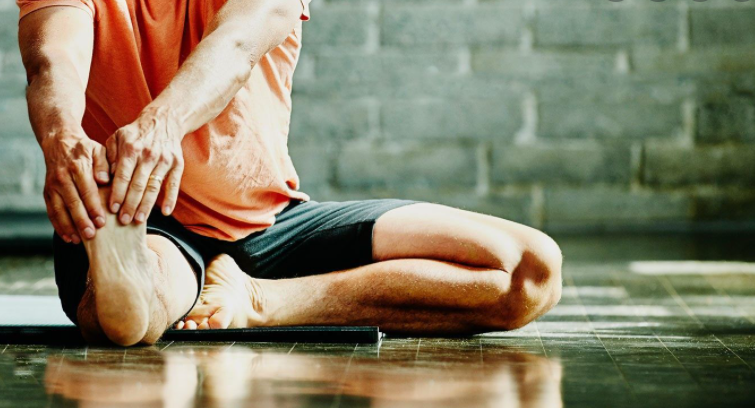
How physiotherapists tackle unhelpful pain beliefs to treat osteoarthritis
Osteoarthritis is a growing problem for older Australians, with the knee being the most common and disabling joint affected.[1]
Knee osteoarthritis alone is estimated to affect approximately 250 million people around the world.[2]
Despite clinical guidelines unanimously recommending regular structured physical activity (aerobic or strengthening exercise) and with benefits similar to commonly used pain relief drugs without the pharmacological side effects, it is unfortunate that many osteoarthritis sufferers neglect exercise as a treatment.[3]
How does pain and the perception of pain affect osteoarthritis symptoms?
Recent studies support the idea that unhelpful beliefs likely contribute to inactivity in people with knee osteoarthritis, leading to a vicious cycle of pain. The majority of people with hip and knee osteoarthritis do not meet physical activity guidelines and are less active than their age-matched counterparts.[4]
- People with osteoarthritis who are inactive are more likely than those who are active to believe that they are physically unable to exercise and that physical activity is unsafe[5]
- People with knee osteoarthritis often focus heavily on pain and hold beliefs that osteoarthritis is an incurable, progressive ‘bone-on-bone’ disease, caused by ‘wear-and-tear’[6]
- people with knee osteoarthritis generally report increased levels of fear of movement, movement-induced injury and report uncertainty as to whether undertaking physical activity will be helpful for them.[7]

Skou ST, et al. Physical Activity and Exercise Therapy Benefit More Than Just Symptoms and Impairments in People With Hip and Knee Osteoarthritis. J Orthop Sports Phys Ther. 2018 Jun;48(6):439-447.
Exercise therapy for osteoarthritis
Compared to the 2 most common pharmaceutical pain relievers, exercise therapy seems to be at least as effective as nonsteroidal anti-inflammatory drugs[8] and 2 to 3 times more effective than paracetamol in reducing pain in knee osteoarthritis.[9]
Like analgesic medication, exercise therapy needs to be taken at a sufficient dose and duration to be effective and ensure optimal and clinically relevant effects on symptoms and impairments
Physiotherapists are experts in the management of osteoarthritis pain
If you have hip or knee osteoarthritis, exercise and physical activity may not only help improve your joint pain but can also boost your overall health and quality of life. Physical activity can be as simple as walking, going for a bike ride, or completing water based exercises during hydrotherapy
The authors of a long term study into osteoarthritis pain propose 7 key recommendations[10]
- Exercise and physical activity should be tailored to your needs and preferences.
- Consider water exercises if it is too painful to exercise on land.
- Supervised exercise therapy over a 6-week period is often helpful to get you started.
- Some people may need 12 weeks of supervised therapy to begin.
- After you complete supervised therapy, you may need periodic “booster sessions” to help with long-term management of your OA pain and overall health.
- Home exercises should be performed to optimize your outcomes.
- You should be sure you understand how to manage flareups in pain and how to modify your exercises when pain increases. The benefits of exercise and physical activity are numerous: they help fight cancer, heart disease, diabetes, and osteoporosis, and improve your mental health. Your physical therapist can help design the right program for you.
Helping people with osteoarthritis become more physically active safely is one of our many areas of expertise at Lane Cove Physio. If you’re experiencing osteoarthritis symptoms, make an appointment at Lane Cove Physio on (02) 9428 5772 or send us an email at [email protected] to discuss your treatment options.
[1] March LM, Bagga H. Epidemiology of osteoarthritis in Australia. Med J Aust. 2004;180(S5):S6–10.
[2] Vos T, Flaxman AD, Naghavi M, et al. Years lived with disability (YLDs) for 1160 sequelae of 289 diseases and injuries 1990-2010: a systematic analysis for the Global Burden of Disease Study 2010. Lancet. 2012;380:2163-2196. https://doi. org/10.1016/S0140-6736(12)61729-2
[3] Fransen M, McConnell S, Harmer AR, et al. Exercise for osteoarthritis of the knee. Cochrane Database of Systematic Reviews.2015, Issue 1. Art. No.: CD004376.
[4] de Groot IB, Bussmann JB, Stam HJ, Verhaar JA. Actual everyday physical activity in patients with end-stage hip or knee osteoarthritis compared with healthy controls. Osteoarthritis Cartilage. 2008;16:436-442.
[5] Dobson F, Bennell KL, French SD, Nicolson PJA, Klaasman RN, Holden MA, et al. Barriers and facilitators to exercise participation in people with hip and/or knee OA: synthesis of the literature using behavior change theory. Am J Phys Med Rehabil. 2016;95(5):372–89.
[6] Bunzli S, O’Brien P, Ayton D, et al. Misconceptions and the acceptance of evidence-based nonsurgical interventions for knee osteoarthritis. A qualitative study. Clin Orthop Relat Res. 2019;477(9):1975–83.
[7] Somers TJ, Keefe FJ, Pells JJ, Dixon KE, Waters SJ, Riordan PA, et al. Pain catastrophizing and pain-related fear in osteoarthritis patients: relationships to pain and disability. J Pain Symptom Manag. 2009;37(5):863–72.
[8] Fransen M, McConnell S, Harmer AR, Van der Esch M, Simic M, Bennell KL. Exercise for osteoarthritis of the knee. Cochrane Database Syst Rev. 2015;1:CD004376. https://doi. org/10.1002/14651858.CD004376.pub3
[9] Bannuru RR, Schmid CH, Kent DM, Vaysbrot EE, Wong JB, McAlindon TE. Comparative effectiveness of pharmacologic interventions for knee osteoarthritis: a systematic review and network meta-analysis. Ann Intern Med. 2015;162:46-54. https://doi.org/10.7326/M14-1231
[10] Skou ST, et al. Physical Activity and Exercise Therapy Benefit More Than Just Symptoms and Impairments in People With Hip and Knee Osteoarthritis. J Orthop Sports Phys Ther. 2018 Jun;48(6):439-447.



